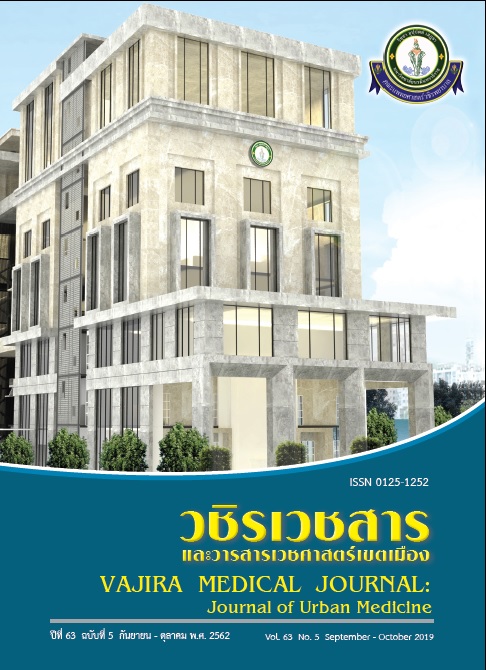Prevalence of Thiamine Deficiency in Cirrhotic Patients Admitted to Vajira Hospital due to Cirrhotic Complications
Main Article Content
Abstract
Objective: To study the prevalence and associated factors of thiamine deficiency in liver cirrhotic patients, Faculty of Medicine Vajira Hospital, Navamindradhiraj University
Methods: Patients with cirrhosis from various causes who were admitted to Vajira Hospital during July 1, 2017 to October 31, 2017 due to any cirrhotic complications were enrolled. Patients who had already received vitamin B1 supplementation were excluded. Blood were collected for complete blood count, liver function testing, gamma-GT level, PT-INR, and random plasma glucose. Vitamin B1 status was determined by coefficient of erythrocyte transketolase activity (aETK) method. Subjective global assessment (SGA) was used to determine nutritional status. All patients were classified with Child-Turcotte-Pugh system to determine the degree of cirrhosis. Primary objective was the prevalence of vitamin B1 deficiency in cirrhotic patients. Secondary outcome was the independent factor predicting the likelihood of vitamin B1 deficiency in such patients.
Results: There were seventy-six eligible patients. Only ten patients (13.2%) were determined to have vitamin B1 deficiency by coefficient of erythrocyte transketolase activity (aETK) method. Five of them had pre-existing alcoholic cirrhosis (50%), three had NASH (30%), one had chronic hepatitis B (10%) and one had chronic hepatitis C (10%). AST:ALT ratio ≥ 2 was the only independent predicting factor associated with vitamin B1 deficiency in these patients.
Conclusion: Vitamin B1 deficiency is not common among patients with liver cirrhosis. Routine vitamin B1 replacement/supplementation is not recommended in such patients. Determination of aETK, vitamin B1 status prior to replacement/supplementation is suggested. AST:ALT ratio ≥ 2 is likely a predictive factor of vitamin B1 deficiency among the cirrhotic patients. Prospective studies to validate this factor are advocated.
Downloads
Article Details
References
Chantal B, Roger B. Nutrition in the Management of Cirrhosis and its Neurological Complications. J clin exp hepatol. 2015; 5:131–40.
Hoyumpa AM. Mechanisms of Thiamine deficiency in chronic alcoholism. Am J Clin Nutr. 1980; 33:2750–61.
Roberta ER, Dario C, Sara M. Diagnosis and treatment of nutritional deficiencies in alcoholic liver disease: Overview of available evidence and open issues; Digestive and Liver Disease. 2015;47 :819–825.
Herve´C, Beyne P, Letteron P, Delacoux E: Comparison of erythrocyte transketolase activity with Thiamine and Thiamine phosphate ester levels in chronic alcoholic patients. Clin Chim Acta. 1995; 234:91–100.
Talwar D, Davidson H, Cooney J, St JO'Reilly D. Vitamin B (1) status assessed by direct measurement of thiamin pyrophosphate in erythrocytes or whole blood by HPLC: comparison with erythrocyte transketolase activation assay. Clinical chemistry. 2000; 46(5):704-10.
D'Amico G, Garcia-Tsao G, PagliaroL. Natural history and prognostic indicators of survival in cirrhosis: a systematic review of 118 studies. J Hepatol. 2006;44(1):217-31.
Lévy S, Hervé C, Delacoux E, ErlingerS. Thiamine deficiency in hepatitis C virus and alcohol-related liver diseases. Digestive Diseases & Sciences. 2002;47(3):543-8.
Singal AK, Charlton MR. Nutrition in alcoholic liver disease. Clinics in Liver Disease. 2012;16:805-26.
Child CG, Turcotte JG. Surgery and portal hypertension. In Child Cg, ed The Liver and Portal Hypertension. Philadelphia: Saunders. 1964;50–64.
BrinM, Ziporin ZZ. Evaluation of Thiamine adequacy in adult humans. Journal of Nutrition. 1965; 86:319-324.
Caine D, Halliday GM, Kril JJ, Harper CG: Operational criteria for the classification of chronic alcoholics: identification of Wernicke’s encephalopathy. J Neurol Neurosurg Psychiatry. 1997;62(1):51-60.
Dancy M, Evans G, Gaitonde M K, Maxwell J D. Blood Thiamine and Thiamine phosphate ester concentrations in alcoholic and non-alcoholic liver diseases. British Medical Journal. 1984; 289.
Rossouw JE, Labadarios D, Krasner N, Davis M, Williams R. Red blood cell transketolase activity and the effect of Thiamine supplementation in patients with chronic liver disease. Sc and J Gastroenterol. 1978;13(2):133-8.
Thomson AD. Mechanisms of vitamin deficiency in chronic alcohol misusers and the development of the Wernicke-Korsakoff syndrome. Alcohol & Alcoholism. 2000; 35:2-7.


